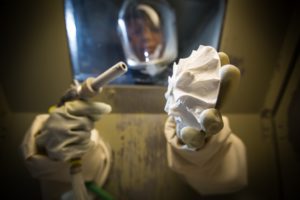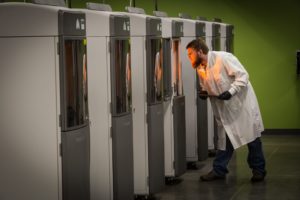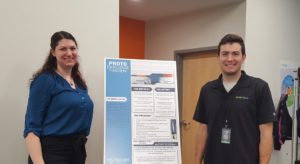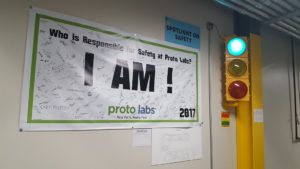The company’s global headquarters is in Minnesota, and Protolabs additionally has manufacturing facilities worldwide including four in the US, eight in Europe, and one in Japan. In 2016, the company opened a dedicated 3D printing facility in Cary, North Carolina — the 77,000-square-foot dedicated campus is home to more than 100 3D printers and houses more than 200 employees. With that haven of activity and expertise, I appreciated the recent opportunity to visit and see first-hand the North Carolina operations. As Protolabs President and CEO Vicki Holt has told us previously, this is the most exciting time to be in manufacturing, and walking through this facility really drove that home.
The large V-shaped building is split by technology, Applications Engineer Joe Cretella explained as we began to walk through; DMLS, SLS, and MJF technologies are off to one side, with SL and PolyJet to the other, with a customer-facing team centered up front.That team, Cretella noted, works with hundreds of projects daily, supporting Protolabs’ instant quoting offering and interfacing with customers. Just as ordering a pizza today can be done fully online without having to actually talk to the person making your pie, Protolabs’ online offering allows for a customer to input a file and pretty instantly receive a quote with lead time and price before the project would be validated and pushed to production.Each of the 3D printing technologies offered also has its own dedicated service team working with specific files. These build prep departments, located near each manufacturing space, work on adding and adjusting supports, ensuring that files can build properly, and getting each project ready for manufacture. We started our walk with metals, visiting with the DMLS build prep team before walking into the metals room. M2 and LaserCusing machines from Concept Laser dominated the space, along with a large sieving station.
Quality quickly became the throughline of my day with Protolabs, as it became very clear that the company is incredibly mindful of the technologies it brings into operations, getting to know and thoroughly understand each machine and technology at hand. Learning from failed prints is part of the experience, and the company maintains a program called Proto Excellence in which team members learn from one another and share their constantly expanding knowledge.“We pride ourselves on how we take care of machines,” Cretella told me as we watched a build in progress. “There’s this consistency and quality of parts we build, time and time again. We’re also learning from failed prints.”
Following our walkthrough of the metals room, we moved into the finishing department for DMLS, where the majority of post-processing requires hands-on work. The manual process extends as well to full machining and hand polishing to finish to customers’ preferences.
From DMLS we moved into SLS and MJF. The build prep teams were again hard at work, checking files and prepping, working with the automated software to ensure the best builds and filling platforms.
“Filling the platform reduces the price for SLS and MJF,” Cretella noted. “We can reduce the cost for higher volumes of price because of the efficiencies allowed here.”
- An SLS part breakout at Protolabs. Image courtesy of Protolabs.
- MJF 3D printing [Photos: Protolabs]
Machines from 3D Systems and HP were hard at work, bringing customer projects into being with nylon and TPU materials. MJF is particularly exciting for Protolabs, as the technology is faster for the company and allows cost savings for customers, Cretella said as we walked. The post-processing for these technologies includes, following print cooldowns, cleaning excess materials from any voids, inspection, and XYZ checking for quality. These technologies offer benefits of being less labor intensive and easier and faster to finish, he noted.
“We started with SLA, and that’s our bread and butter; we have a lot of experience with 3D Systems,” Cretella told me as we moved into the next areas.
“We pride ourselves on our ability to really dial in to a machine and understand its parameters.”
An impressive variety of machines from 3D Systems filled this room, including legacy machines modified to fit current needs alongside newer offerings like the ProJet 6000 HD. Legacy Viper machines that maintain their original look have seen some significant internal updates. These are the only machines that can run Protolabs’ proprietary green resin material.
“I like to compare these to a race car; the outside looks like every other car, but the engines are all unique. For these machines, everything inside has been heavily modified by us,” Cretella said.
- One bank of 3D Systems 3D printers
- PolyJet 3D printing at Protolabs. Image courtesy of Protolabs.
Located nearby were Stratasys‘ PolyJet offerings, which will be moving into another wing in the building soon as these capabilities will be expanding. Cretella noted these as being a “good process for prototyping overmolding.”
Near these machines were the prep and post-processing work stations. Custom finishing for SLA and PolyJet print jobs is performed to each job’s specifications and can include removing layer lines, Pantone color matching, clear finishes, and creating trade show-quality parts to show off. Final inspection ensure that tolerances and quality are checked prior to shipping.
Throughout our tour, Cretella underscored the importance to Protolabs of understanding and satisfaction. In their quest to provide the best parts and service to their customers, the team throughout Protolabs’ operations ensure that they have a deep understanding of each technology, machine, and material they offer. Internal operations as well are held to a high standard, with Proto Excellence and regular safety reminders in place; a stop light for safety was at green, and Cretella noted that this was the only color he’d ever seen it on.
- Me with Joe and a Proto Excellence easel
- Safety gets the green light at Protolabs [Photo: Sarah Goehrke]
Stay tuned for an interview with Joe Cretella for additional discussion of Protolabs’ capabilities and ethos regarding additive manufacturing.
Discuss Protolabs and other 3D printing topics at 3DPrintBoard.com or share your thoughts in the comments below.
Subscribe to Our Email Newsletter
Stay up-to-date on all the latest news from the 3D printing industry and receive information and offers from third party vendors.
You May Also Like
Gorilla Sports GE’s First 3D Printed Titanium Cast
How do you help a gorilla with a broken arm? Sounds like the start of a bad joke a zookeeper might tell, but it’s an actual dilemma recently faced by...
Nylon 3D Printed Parts Made More Functional with Coatings & Colors
Parts 3D printed from polyamide (PA, Nylon) 12 using powder bed fusion (PBF) are a mainstay in the additive manufacturing (AM) industry. While post-finishing processes have improved the porosity of...
$25M to Back Sintavia’s Largest Expansion of Metal 3D Printing Capacity Since 2019
Sintavia, the digital manufacturing company specializing in mission-critical parts for strategic sectors, announced a $25 million investment to increase its production capacity, the largest expansion to its operations since 2019....
Velo3D Initiates Public Offering in a Bid to Strengthen Financial Foundations and Drive Future Growth
Velo3D (NYSE: VLD) has been among a number of publicly traded 3D printing firms that have attempted to weather the current macroeconomic climate. After posting a challenging financial report for 2023,...









































